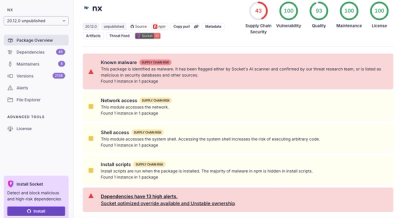
Security News
Nx npm Packages Compromised in Supply Chain Attack Weaponizing AI CLI Tools
Malicious Nx npm versions stole secrets and wallet info using AI CLI tools; Socket’s AI scanner detected the supply chain attack and flagged the malware.
@igne-agency/igne-components
Advanced tools
The Kuura Component Library is a modern, lightweight, and reusable component library built with React and TypeScript. It is designed to streamline development by providing a set of high-quality UI components that are easy to use, customizable, and optimized for performance.
Warning The package has not been published yet.
To install the library in your project, use npm or yarn:
npm install @kuura/component-library
# or
yarn add @kuura/component-library
Import the global styles in your project:
import '@kuura/component-library/dist/assets/config.css';
You can reference the global styles file to see the available customizations. An example customization is shown below:
:root {
--color-primary: var(--color-orange);
--color-secondary: var(--color-purple);
--font-family-sans: 'Arial', sans-serif;
--font-size-md: 1.25rem;
--radius: 0.5rem;
--spacing-md: 1.5rem;
--padding-md: 1.5rem;
--shadow-md: 0 0 1rem rgba(0, 0, 0, 0.2);
}
You can then use the components in your project like such:
import { Button } from '@kuura/component-library';
function App() {
return <Button color="primary">Click Me</Button>;
}
export default App;
Make sure you have the following installed:
git clone https://github.com/your-org/kuura-component-library.git
cd kuura-component-library
npm install
# or
yarn install
Prettier and ESLint configurations have been set up for the project. Make sure to have those working in your editor.
Each component should be placed in its own folder within the src/components directory. The component folder should contain the following files:
ComponentName.tsx – The component file, when necessary, the component can be split into multiple files.ComponentName.stories.tsx – The Storybook file for the component.ComponentName.test.tsx – The unit test file for the component.ComponentName.module.css – The CSS module file for the component.When defining variables in the component, you can pass them through the style prop. For example:
type ButtonProps = React.ButtonHTMLAttributes<HTMLButtonElement> & {
color?: ThemeColor;
textColor?: 'light' | 'dark' | 'accent';
size?: Size;
};
export const Button: React.FC<ButtonProps> = ({ children, ...props }) => {
return (
<button
className={clsx(
styles.button,
styles[`size-${props.size || 'md'}`],
styles[`text-${props.textColor || 'light'}`]
)}
style={colorShades(props.color || 'primary')}
{...props}
>
{children}
</button>
);
};
colorShades – This function returns the color shades based on the color passed to it. This way you can access color-x in the css module file.ThemeColor – this type defines the possible color options that are available in the theme. These colors can be customized by the user of the library in their own CSS file.Size – this type defines the possible size options for a given variable. (sm,md,lg)When using a color inside of a component we use the --color-x variable name, this way any given color can be passed in, parsed by the colorShades function, and then used in the component.
Run the Vite development server:
npm run
# or
yarn dev
We use Vite Test for unit testing:
npm run test
# or
yarn test
To view and test components interactively, run Storybook:
npm run storybook
# or
yarn storybook
To build the library for production:
npm run build
# or
yarn build
FAQs
A Component Library for IGNE React-based projects
The npm package @igne-agency/igne-components receives a total of 12 weekly downloads. As such, @igne-agency/igne-components popularity was classified as not popular.
We found that @igne-agency/igne-components demonstrated a healthy version release cadence and project activity because the last version was released less than a year ago. It has 0 open source maintainers collaborating on the project.
Did you know?

Socket for GitHub automatically highlights issues in each pull request and monitors the health of all your open source dependencies. Discover the contents of your packages and block harmful activity before you install or update your dependencies.

Security News
Malicious Nx npm versions stole secrets and wallet info using AI CLI tools; Socket’s AI scanner detected the supply chain attack and flagged the malware.

Security News
CISA’s 2025 draft SBOM guidance adds new fields like hashes, licenses, and tool metadata to make software inventories more actionable.

Security News
A clarification on our recent research investigating 60 malicious Ruby gems.